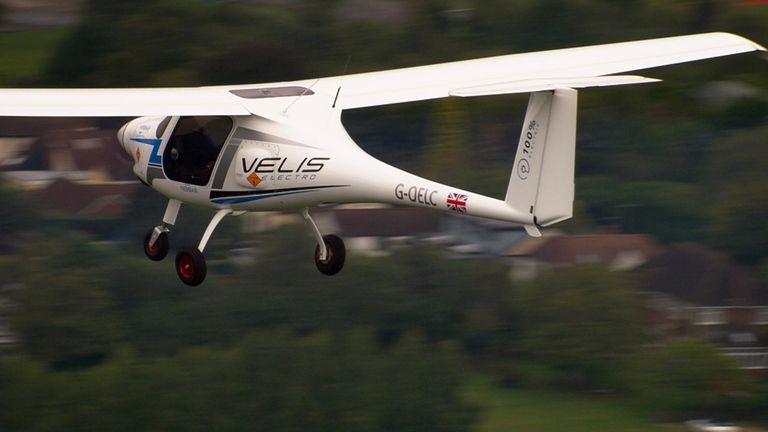Sitting at the end of the runway, with just seconds before getting clearance for take-off, the spinning propeller of the plane I am in sitting in unexpectedly judders to a quick, and ominous, halt.
Sitting next to me, pilot and instructor Adam Twidell, senses my nerves.
“It’s just another thing that is so great about electric planes” he grins. “Unlike a conventional plane which would sit idling and burning fossil fuels, an electric plane just stops and we conserve energy.”
And with that, the propeller starts to whirr once again and we charge down the runway and up into the skies over Surrey.
With just two seats, the Pipistrel Velis Electro is an all-electric powered aircraft designed for pilot training and short hops.
It is the first zero emissions aircraft certified for normal operations. In fact, its only emissions are generated during its construction, maintenance, eventual end-of-life disposal and from the electricity used for charging.
On board it feels remarkably smooth, it is quieter because there is no combustion engine and there are fewer vibrations.
Fairoaks Airport in Surrey now has the UK’s first fossil fuel free flying school.
Student pilot Cameron Taylor is taking the first steps towards his generation flying in a complete fossil fuel free sky.
Sitting inside the Pipistrel Velis Electro he is being trained to fly, he explains that it is much simpler to control than regular aircraft.
“Regular aircraft have a lot more moving parts, there is a lot more that you have to think about, but with this aircraft there are only four switches that control the main instruments,” he says.
Aviation sustainability solutions provider 4AIR helps advise the aviation industry on how to become greener and is behind the flying school with partner Synergy Flight Training.
4AIR’s Kennedy Ricci, believes new environmentally engaged pilots will demand the journey to ‘jet zero’ happens more quickly.
“As the younger generation learns to fly this aeroplane their want for more aircraft that are electric, and larger, is only going to grow,” he says.
The aircraft takes just 45 minutes to charge and powering a full battery only costs a few pounds, something else which appeals to students paying for their own lessons. 4AIR offsets the energy used.
Electric planes may one day make good commuter aircraft for short journeys, and more than a dozen UK airports currently have charging points.
It’s an unlikely thought that battery-powered airliners will ever carry us across the Atlantic.
Sustainable aviation fuels (SAFs) are being developed but SAF is expensive and so far we are producing only a very small amount of what is needed.
Airlines are also investing in more fuel-efficient aircraft operational improvements, such as optimising flight paths and reducing weight.
Research is also being carried out into long-term solutions such as hydrogen-powered aircraft.
Back in the air and I keep half an eye on the battery power monitor.
Adam assures me he doesn’t suffer from “range anxiety” and we have an hour’s worth of flying in the battery, but he always lands at least 15 minutes before time is up.
He lets me take control for a couple of minutes, and my clammy hands gently move the steering column. As we swoop over Surrey we spot Thorpe Park out of one window and even Heathrow and its gas-guzzling jets out of the other.
Back safely on the ground, I catch up with Cameron again.
“It’s really refreshing knowing I am contributing to an eco-friendly future” he says. “I am helping prove this is something we can do. A lot of people don’t realise just how far the technology has come”.

